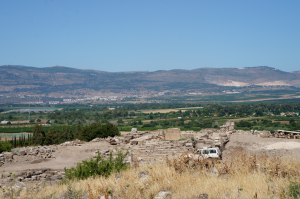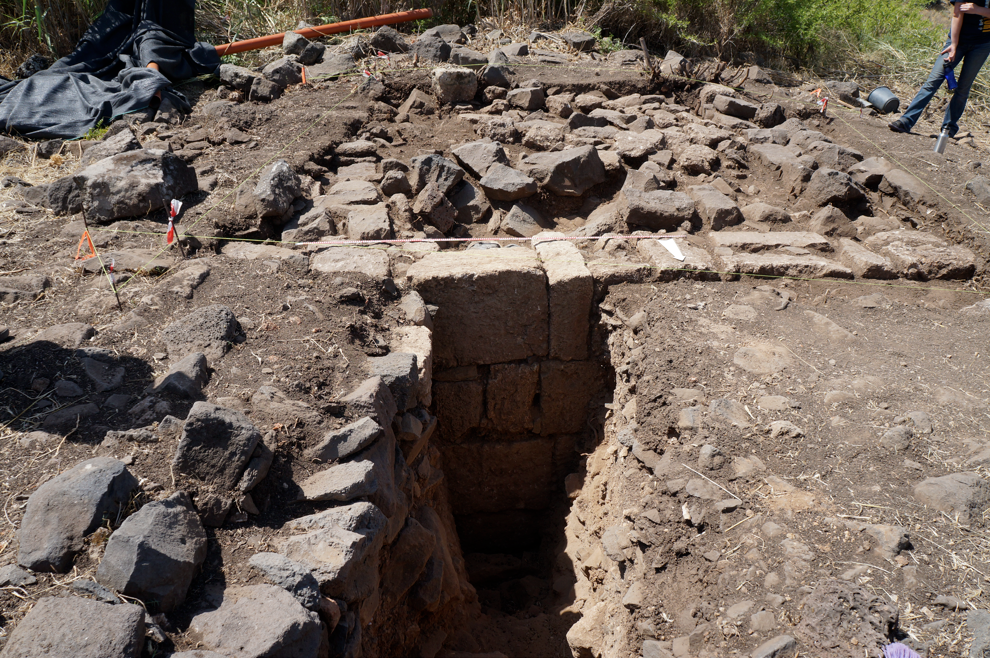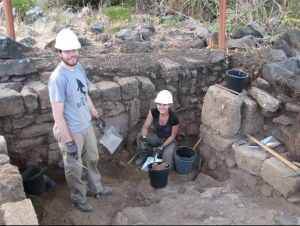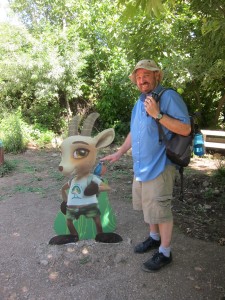In her usual thoughtful manner, Elvira has articulated (in the post below) the sentiments shared by all of those returning to Omrit after months of nostalgia and excitement. Thus, I will spare all a reiteration and will simply begin with a short background of the state of our square. In this dig season, I am working with Professor Jason Schlude from Duquesne University, Connor Dempsey ‘13 from Williams College, and students from Carthage College and Queens College. We started not with a new square, but a “probe trench,” dug in the last two weeks of the last season.
This trench originally resulted from a survey of the surrounding area beyond the temple precinct, specifically 70 meters northeast of it. Although many fragments of pottery were found during the surface survey all over the east hill and the slope leading down into the wadi to our north, compelling factors such as distinct patches of lush vegetation (perhaps indicative of a spring source for a bath) and the surface finding of limestone and basalt blocks of former walls led us to start a probe last summer. Some of us, including Lydia Heinrichs ’15 and I, excavated the probe, which was never fully dug (bedrock had not been found), at various stages. When my new square mates and I returned to this probe at the beginning of this season, we found ourselves almost 1.5 m deep in an approximately 3 x 1 m trench surrounded by walls of rocks: we have a presumably early southern ashlar limestone wall in a header and stretcher construction, a northern basalt wall at roughly the same height, and a possible eastern wall, though it looks more like a collapse or fill of some sort with a mix of both limestone and basalt blocks.
We continued working in the trench and found some pottery and many chunks of conglomerate plaster paving. One of our special finds was perhaps a dark blue glass rim of a piriform or vase about 5 cm in diameter with its neck still intact. After several days of digging in this deep trench we still did not find bedrock and were unsure whether we’ve found the foundation trench for the southern wall at all. As we cleared out the area around the probe trench for another square that we’re starting this season, in addition to digging the old one, we discovered the surfaces of limestone blocks that lined southeast towards northwest, towards the southern ashlar wall in our trench. We then decided to open a full 4 x 4 m square immediate south of our trench to catch this possible wall in the east and to uncover more of our ashlar wall in the north.
Working in this probe area, we are unfortunately separated from other students and supervisors excavating in the squares just north of the temple, but it does not dampen our enthusiasm and excitement for what we might uncover each day, especially because our area has never been excavated before excepting the probe trench of the last season. After battling thick, snakelike roots and resilient bamboo stalks and hauling boulders and buckets of dirt out of the square into a lengthening dump promontory, we found four walls of different construction, and presumably different periods, and architectural fragments such as half a column drum and a cornice. Among our collection of artifacts are lots of pottery, a complete lamp and many lamp fragments, five coins, and three spindle whorls. Although we’ve found many plaster fragments in the upper strata of the square, we recently stumbled on a mass of plaster fragments that might be a collapse or a fill. Embedded in this accumulation are an intact rim and bases of storage jars and many large chunks of pottery from the 4th or 5th century. We’ve many speculations as to what our structure might be and how these chunks of plaster got there: perhaps we are in a storage room of a house with an upper story that had collapsed, or perhaps we are in a courtyard with a fill? Was this just an unfortunate meeting between a lamp merchant and a poor plasterer and his wife, a vendor of cooking pots, in a picnic pavilion? We eventually documented and removed this significant plaster-filled layer to discover something that we’ve been hoping to find. Stay tuned, for Connor will elaborate on our exciting find in this square (and why we’re returning to our trench) in his coming post!




